In today’s world, healthcare is shifting rapidly toward patient convenience and accessibility. One such revolutionary advancement is the option of X-Ray at home with professional radiology services. Imagine having advanced diagnostic imaging done without the need to travel to a hospital or diagnostic center. This service combines modern portable X-ray machines with skilled radiology professionals, ensuring patients receive accurate and timely reports in the comfort of their own homes. Whether it’s for elderly patients, those with mobility issues, or individuals in emergency situations, home-based X-rays are transforming the way we approach healthcare.
Introduction to X-Ray at Home
What is an X-Ray at Home Service?
An X-Ray at home service allows patients to undergo radiological imaging in their own living space rather than visiting a diagnostic center. Using portable X-ray machines, trained technicians visit the patient’s home, capture high-quality images, and send them to radiologists for interpretation. This service is especially valuable for people who cannot easily leave their homes due to illness, injury, or old age.
Instead of waiting for hours in a hospital, patients can now schedule an X-ray at their convenience. The machine is lightweight, mobile, and designed for quick set-up, ensuring that the process is smooth, safe, and efficient. The results are usually shared digitally with both patients and doctors, which speeds up treatment decisions.
Evolution of Radiology Services in Modern Healthcare
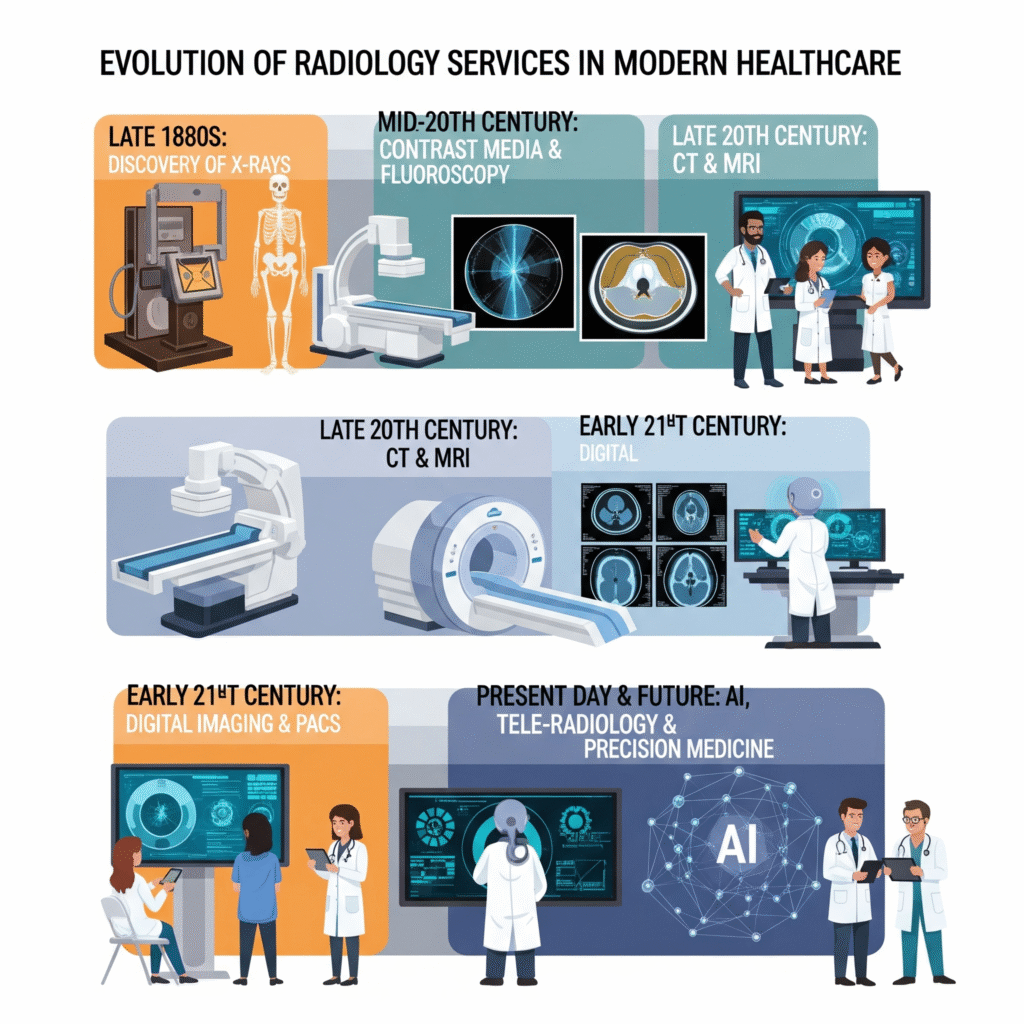
Traditionally, X-rays were available only in hospitals and specialized centers due to the bulky equipment required. However, with advancements in digital radiography and portable imaging machines, radiology has now entered the home healthcare sector. What once required an entire facility can now be carried out with compact devices, making radiology services more flexible and patient-centered.
This evolution represents a broader trend in healthcare: bringing services directly to patients. Telemedicine, home blood tests, and home nursing care have already gained momentum, and X-ray at home is becoming a natural extension of this shift. It reflects a growing recognition that patients deserve comfort, convenience, and timely care without unnecessary stress.
Importance of Home-Based Radiology
Convenience and Accessibility
One of the biggest advantages of home-based radiology is accessibility. Many patients live far from diagnostic centers, and traveling for an X-ray can be both time-consuming and physically exhausting. With X-ray at home, patients save travel time, avoid waiting in crowded lobbies, and experience faster service—all from their own home environment.
This service also benefits caregivers. Family members no longer need to arrange transportation or take long hours off work to accompany their loved ones. Everything is handled at home, making the experience stress-free for both patients and their families.
Benefits for Elderly and Bedridden Patients
Elderly patients, particularly those with chronic illnesses, often struggle with frequent hospital visits. Bedridden individuals face even greater challenges, as moving them requires wheelchairs, stretchers, or even ambulances. In such cases, X-ray at home with professional radiology services becomes a blessing.
The service minimizes physical strain, reduces discomfort, and avoids unnecessary exposure to hospital environments where infections are more common. It ensures that elderly patients receive the diagnostic care they need without compromising their well-being.
Reducing the Need for Hospital Visits
Every hospital visit comes with its own set of challenges—long queues, risk of infections, and time away from home. By choosing an X-ray at home service, patients can skip all of this. For routine or follow-up X-rays, this becomes especially beneficial, as patients don’t have to repeat the exhausting cycle of traveling and waiting.
Moreover, during situations like a pandemic, home-based X-rays drastically reduce exposure to contagious diseases. It allows healthcare providers to continue diagnostics while keeping patients safe.
How X-Ray at Home Works
Portable X-Ray Machines and Technology
Modern portable X-ray machines are compact, efficient, and capable of producing high-resolution images. They use digital radiography technology, which means the images are instantly available in digital format. These machines are designed to be safe, with minimal radiation exposure, and are operated by certified technicians who ensure accurate positioning for quality imaging.
Unlike the traditional bulky machines in hospitals, portable X-ray units can be carried into a patient’s home, set up within minutes, and adjusted to capture the required image without moving the patient too much.
Step-by-Step Process of Getting an X-Ray at Home
Here’s how the process usually works:
- Booking the Service – Patients or caregivers schedule an appointment online or by phone.
- Technician Visit – A certified radiology technician arrives at the patient’s home with the portable machine.
- Setup and Positioning – The technician positions the patient and the machine properly for the required scan.
- Capturing the Image – The X-ray is taken in seconds, with minimal discomfort.
- Image Transmission – The digital X-ray is securely shared with radiologists for interpretation.
- Report Delivery – Patients receive reports electronically, often within hours, which can then be shared with doctors.
The entire process is simple, patient-friendly, and ensures minimal disruption to daily life.
Role of Professional Radiology Technicians
The success of X-ray at home services depends heavily on the expertise of professional radiology technicians. These trained professionals not only handle the equipment but also ensure proper positioning of the patient, correct exposure settings, and adherence to safety measures.
They are skilled in handling different patient conditions—whether it’s an elderly patient with fragile bones, a child who may be restless, or someone in pain due to injury. Their ability to adapt and deliver accurate images ensures that doctors receive clear and reliable results for diagnosis.
Advantages of X-Ray at Home with Professional Radiology Services
Faster Diagnosis and Treatment
With home-based X-rays, patients receive quicker results compared to traditional setups. Since images are captured digitally and transmitted instantly, radiologists can analyze them without delay. This speed is crucial for patients in urgent need of medical attention, as timely diagnosis often leads to faster treatment and recovery.
Comfort and Privacy of Home Environment
Being examined in a familiar environment reduces stress and anxiety for patients. Hospitals often feel intimidating, while the home setting provides reassurance and comfort. Privacy is another key factor—patients can undergo the procedure without the discomfort of being in crowded spaces.
Reduced Risk of Infections in Healthcare Facilities
Hospital-acquired infections are a serious concern, especially for vulnerable patients. Choosing an X-ray at home significantly reduces exposure to such risks. This becomes particularly important during viral outbreaks, when limiting contact with crowded facilities is crucial for patient safety.
Who Can Benefit from X-Ray at Home?
Patients with Chronic Illnesses
Patients suffering from chronic conditions often require regular imaging. Traveling for frequent check-ups can be exhausting and impractical. With X-ray at home, these patients can manage their health without the burden of repeated hospital visits.
Elderly Individuals with Limited Mobility
For elderly patients who struggle with walking or need assistance, home-based X-rays provide unmatched convenience. Families no longer need to arrange special transport or risk injury by moving them unnecessarily.
Children and Patients with Special Needs
Children often feel anxious in hospitals, and those with special needs may find it even more overwhelming. Having an X-ray at home creates a calmer environment, making the process easier for both the child and caregivers.
Post-Surgical and Emergency Cases
Patients recovering from surgery or dealing with sudden injuries often need urgent imaging. Instead of rushing them to the hospital, a professional home X-ray service ensures they get the necessary scans quickly, aiding in effective treatment planning.
Types of X-Rays Available at Home
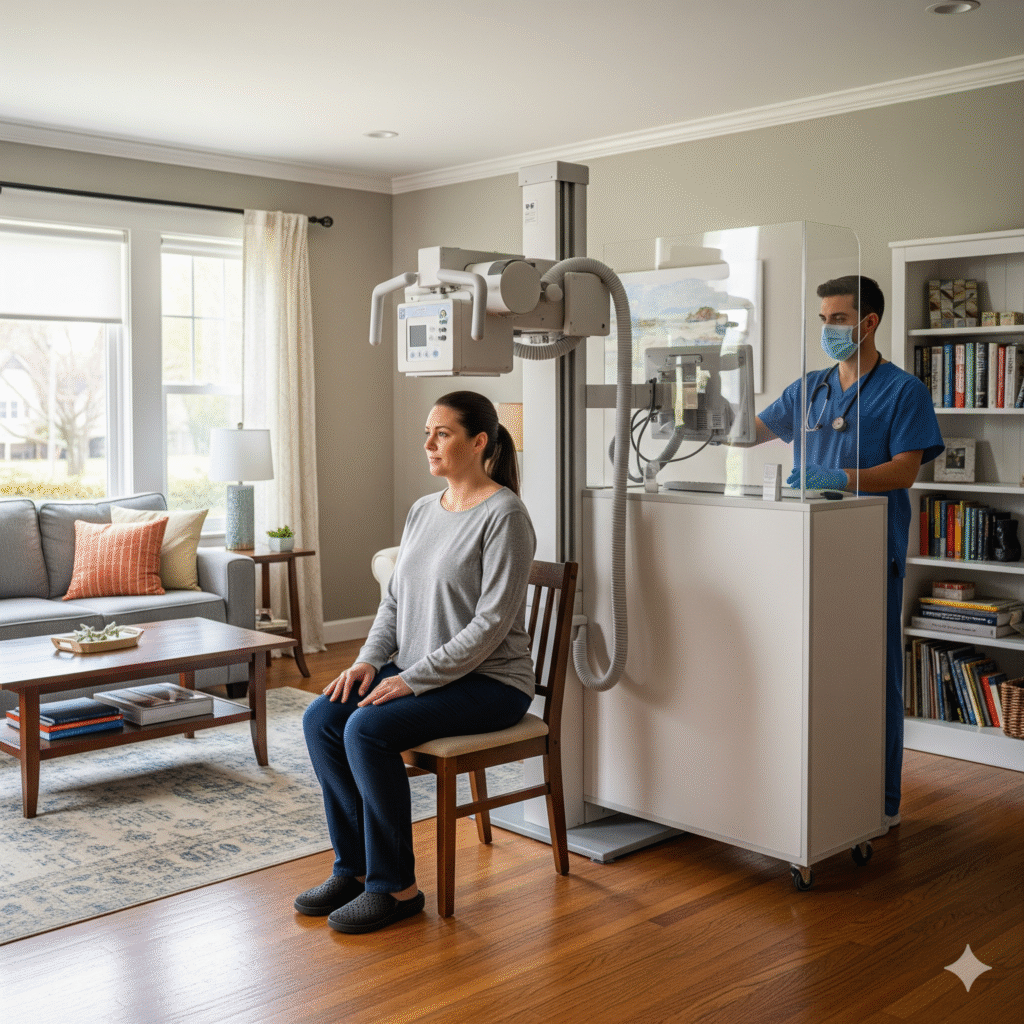
Chest X-Ray at Home
A chest X-ray at home is one of the most commonly requested services. It helps diagnose respiratory issues, infections, lung diseases, and even heart conditions. Patients with chronic respiratory problems such as asthma, pneumonia, or COPD often require frequent imaging, which can be stressful if they need to visit a hospital every time.
By opting for a home-based chest X-ray, patients receive quick and accurate results without leaving their home. Professional technicians set up the equipment carefully to capture detailed chest images, which are then reviewed by radiologists. The reports are usually shared electronically with both the patient and their doctor, enabling prompt medical decisions.
Limb and Bone X-Rays at Home

Injuries to arms, legs, hands, or feet often require an X-ray for proper evaluation. A limb X-ray at home is highly convenient for patients who have difficulty moving due to fractures, sprains, or joint pain.
Instead of enduring painful transportation to a hospital, the patient can remain at home while a technician captures the necessary images. This is particularly useful for elderly individuals who are more prone to falls and bone injuries. The process is safe, quick, and ensures minimal discomfort.
Spine and Joint X-Rays
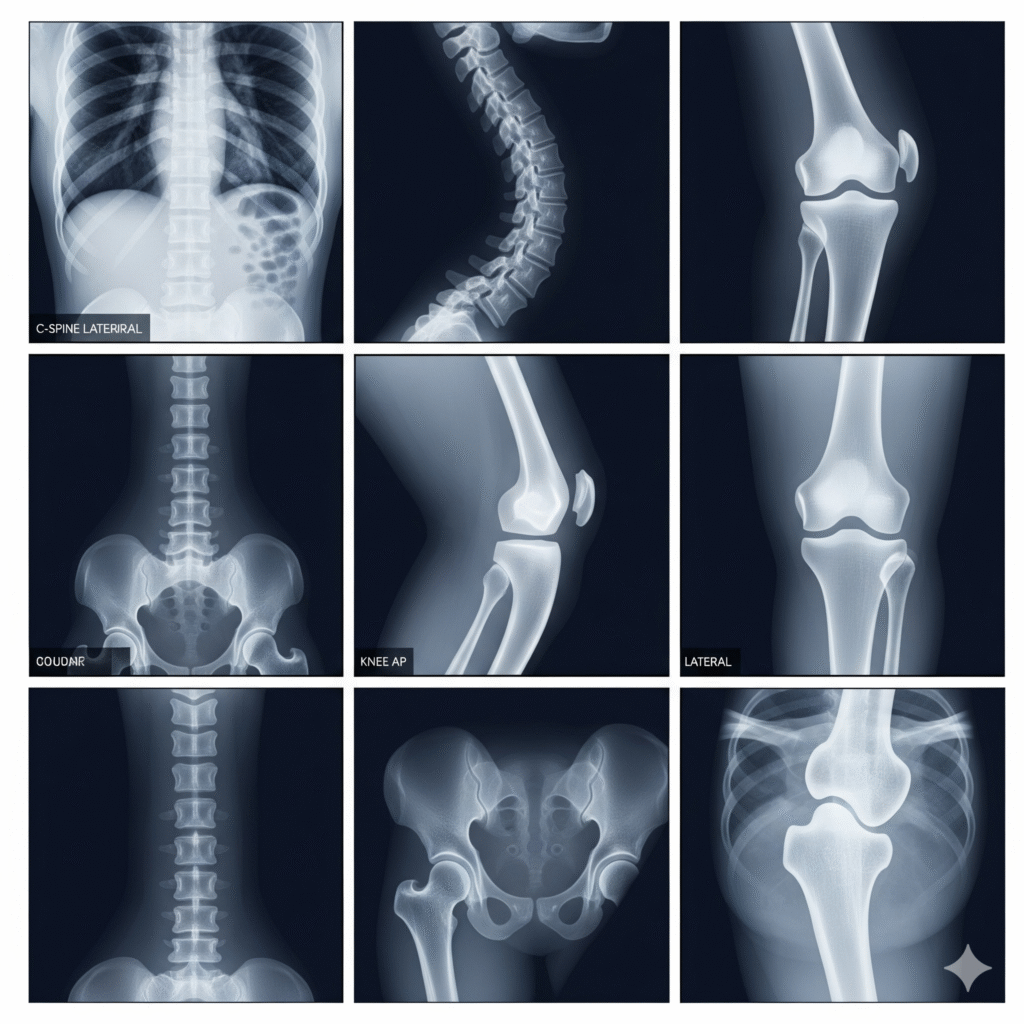
Patients with back pain, arthritis, or spinal injuries often require repeated imaging. A spine X-ray at home provides detailed views of the vertebrae, joints, and spinal structure without requiring the patient to undergo stressful hospital visits.
Similarly, joint X-rays at home help in diagnosing arthritis, osteoporosis, and joint damage. These scans are especially valuable for long-term monitoring of chronic orthopedic conditions.
Dental and Maxillofacial X-Rays
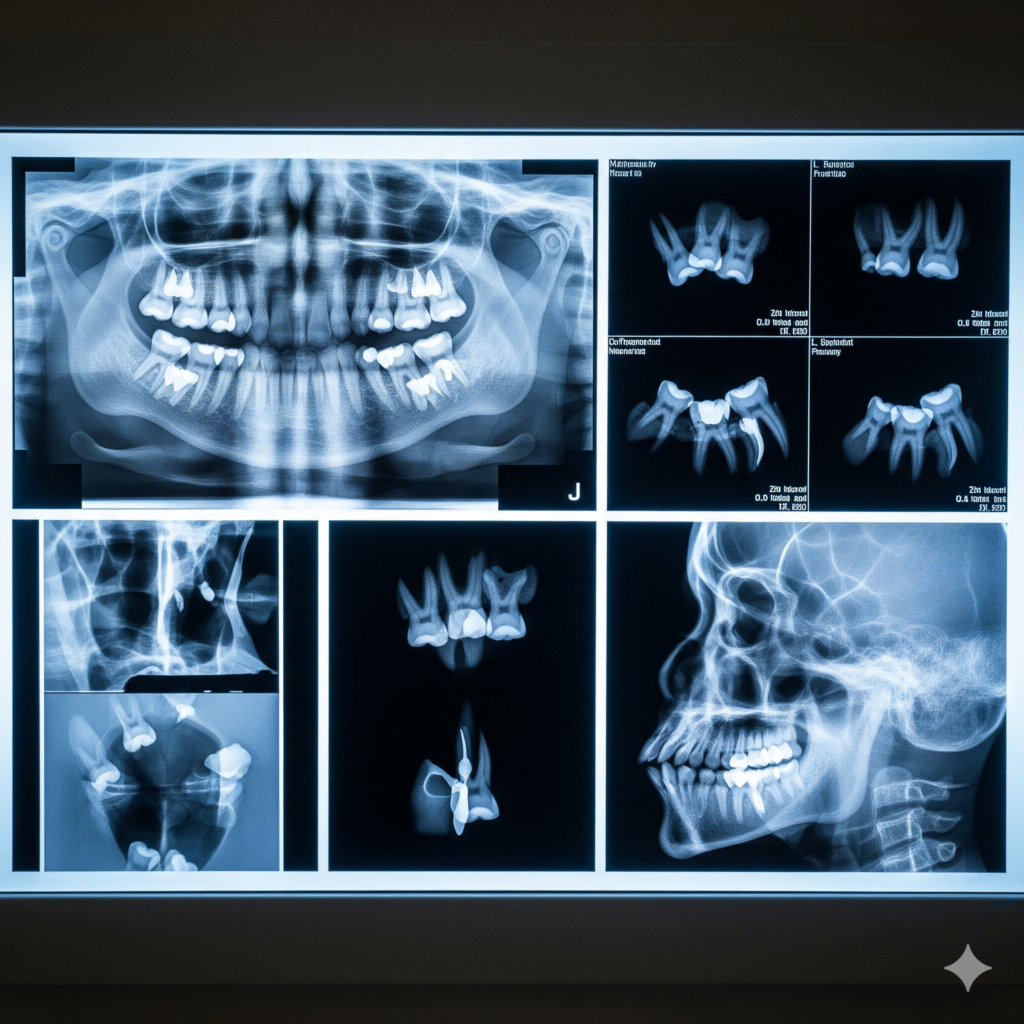
Advancements in portable X-ray technology now allow even dental and maxillofacial imaging at home. These scans are crucial for diagnosing dental infections, jaw fractures, or sinus-related conditions. Home-based dental X-rays are particularly beneficial for children and elderly patients who find dental clinics overwhelming.
Safety of X-Ray at Home Services
Radiation Safety and Modern Equipment
One of the most common concerns patients have about X-rays is radiation exposure. Fortunately, modern portable machines are designed to use minimal radiation while still producing high-quality images. In fact, today’s digital radiography systems expose patients to significantly lower radiation compared to older machines used in traditional hospitals.
Proper Shielding and Safety Measures
Professional technicians follow strict safety guidelines while performing X-rays at home. Patients are often given protective lead aprons or shields to minimize unnecessary exposure. Technicians also take precautions to maintain safe distances and angles during imaging.
This ensures that not only the patient but also family members present in the room are protected from exposure. Safety remains a top priority in every step of the procedure.
Professional Handling of Equipment
Unlike older systems that required specialized rooms, modern portable machines are designed to be safe for use in home environments. Radiology professionals are trained to operate these devices in a way that ensures both patient safety and accuracy in results. Their expertise guarantees that the imaging process is smooth, efficient, and risk-free.
Cost of X-Ray at Home Services
Factors Affecting Pricing
The cost of X-ray at home services can vary depending on several factors such as the type of X-ray needed, the location of the patient, and the urgency of the request. Specialized scans like chest or spine X-rays may be priced differently compared to simpler limb X-rays.
Cost Comparison with Hospital X-Rays
While hospital X-rays may seem cheaper at first, patients must also consider the hidden costs of transportation, time lost, and the physical effort required. For bedridden or elderly patients, the added cost of arranging ambulances or special vehicles can be significant.
When these factors are considered, home-based X-ray services often prove to be more cost-effective, especially for patients who need regular scans.
Insurance Coverage and Reimbursement
Many insurance companies now recognize the value of home-based diagnostic services and may offer reimbursement for X-ray at home procedures. Patients should always check with their providers about coverage options, as this can further reduce costs and make the service more affordable.
Technology Behind Portable X-Ray at Home

Digital Radiography and Its Benefits
Portable X-ray machines rely on digital radiography (DR), which provides several benefits over traditional film-based imaging. DR systems produce instant images that can be stored, shared, and analyzed electronically. This eliminates delays caused by film development and ensures doctors have quick access to results.
Cloud-Based Image Sharing with Doctors
Once an X-ray is captured at home, the image can be uploaded securely to a cloud system where doctors and specialists can access it from anywhere. This allows for real-time collaboration between radiologists, general physicians, and specialists, ensuring faster treatment planning.
Integration with Telemedicine
The rise of telemedicine has made home-based X-rays even more valuable. A patient can undergo an X-ray at home, have the results uploaded online, and immediately consult a doctor via video call. This seamless integration between radiology and telehealth creates a complete home-care ecosystem for patients.
Role of Professional Radiologists
Image Interpretation and Reporting
While technicians handle the actual scanning, professional radiologists play a crucial role in interpreting X-ray images. Their expertise ensures that subtle abnormalities are detected and accurately reported. The collaboration between home-based services and radiologists maintains the same quality standards as hospital diagnostics.
Collaboration with Primary Care Physicians
Once the radiologist prepares a report, it is often shared with the patient’s primary care doctor or specialist. This collaboration ensures that the diagnosis is aligned with the patient’s ongoing treatment plan. Having reports digitally available makes coordination between multiple doctors smoother and more efficient.
Ensuring Accuracy and Quality in Diagnosis
Accuracy is the cornerstone of radiology. By combining advanced digital imaging technology with the expertise of professional radiologists, home-based X-ray services guarantee that patients receive reliable reports. The quality of these diagnostics is often comparable to—or even better than—traditional hospital-based imaging.
X-Ray at Home for Emergency Situations
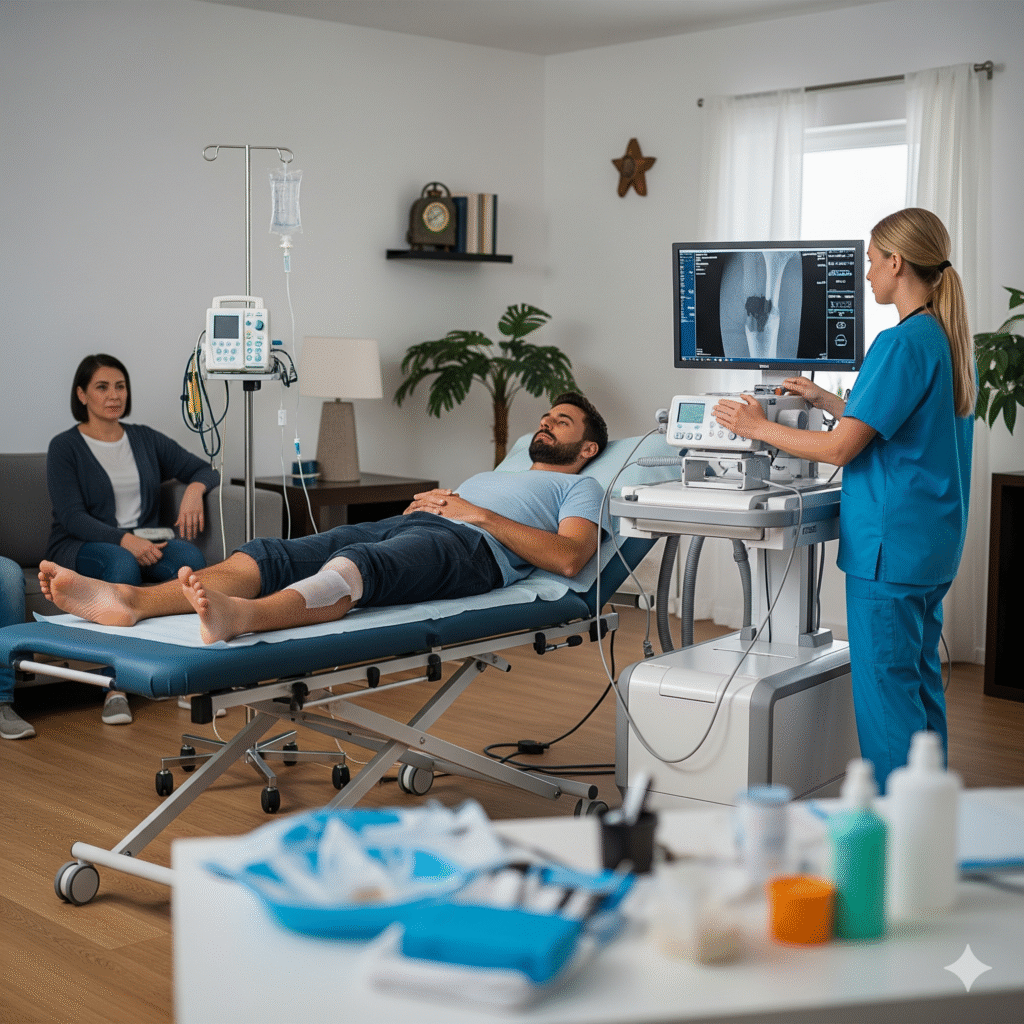
Accidental Injuries at Home
Accidents can happen anywhere, and often the first step after an injury is to get an X-ray. For example, if someone falls at home and experiences severe pain in their leg or arm, rushing to a hospital might not always be possible. This is where X-ray at home for accidental injuries becomes extremely valuable.
Instead of moving the patient, which could worsen their condition, a portable X-ray machine can be brought to their home. The technician captures detailed images of the injured area, and radiologists interpret the results. This makes it easier for doctors to confirm whether the injury is a fracture, sprain, or dislocation and suggest immediate treatment or hospitalization if required.
Sudden Chest Pain and Breathing Issues
When patients experience sudden chest pain or difficulty breathing, an urgent chest X-ray may be needed to rule out conditions like pneumonia, lung infections, or even heart-related issues. Transporting a patient in such a condition could be risky and time-consuming.
With home X-ray services, patients get instant access to diagnostic imaging without leaving their home. Radiologists can quickly review the images and provide doctors with critical information, helping them start treatment without delay.
Night-Time and Urgent Care Needs
Medical emergencies don’t always happen during the day. Sometimes patients may require imaging late at night or in urgent situations. Many X-ray at home services operate 24/7, ensuring patients have access to care whenever they need it. This round-the-clock availability gives families peace of mind, knowing that professional radiology support is just a phone call away.
Comparing X-Ray at Home vs. Traditional Radiology Centers
Speed and Accessibility
In traditional radiology centers, patients often face long wait times, paperwork, and crowded waiting rooms. With X-ray at home, the process is far more efficient. Technicians arrive at the patient’s doorstep, perform the scan, and send results directly to doctors. This not only saves time but also ensures patients receive faster medical attention.
Patient Experience and Comfort
Hospitals can feel overwhelming, especially for elderly individuals or patients in pain. In contrast, home-based X-rays provide comfort, privacy, and reduced anxiety. Patients remain in their familiar environment, surrounded by loved ones, which makes the overall experience less stressful.
Limitations of Home-Based X-Rays
While home X-rays offer many benefits, they do have limitations. Certain complex imaging procedures, like CT scans, MRIs, or advanced contrast-based studies, cannot be performed at home. In such cases, patients may still need to visit specialized diagnostic centers. However, for routine and urgent X-rays, home-based services are an excellent solution.
Preparing for an X-Ray at Home Appointment
What Patients Need to Know Beforehand
Before scheduling an X-ray at home appointment, patients should be aware of a few basic things:
- The type of X-ray required (chest, limb, spine, etc.)
- Any previous imaging records for comparison
- Instructions from their doctor regarding the scan
Preparing these details in advance ensures that the technician and radiologist have all the necessary information to provide accurate results.
How to Make the Process Smooth
To make the process smooth, patients should:
- Clear some space in the room where the X-ray will be performed.
- Wear comfortable clothing without metal objects like zippers or belts.
- Keep family members at a safe distance during the procedure.
These small steps help technicians perform the imaging efficiently and safely.
Aftercare and Follow-Up
Once the X-ray is complete, patients usually receive their reports electronically. It is important to share these results with the treating physician as soon as possible. If further treatment or additional scans are required, the doctor will provide instructions.
In cases of serious findings, immediate medical attention may be advised. Patients should always keep emergency contacts handy for quick follow-up care if needed.
Future of Home-Based Radiology Services
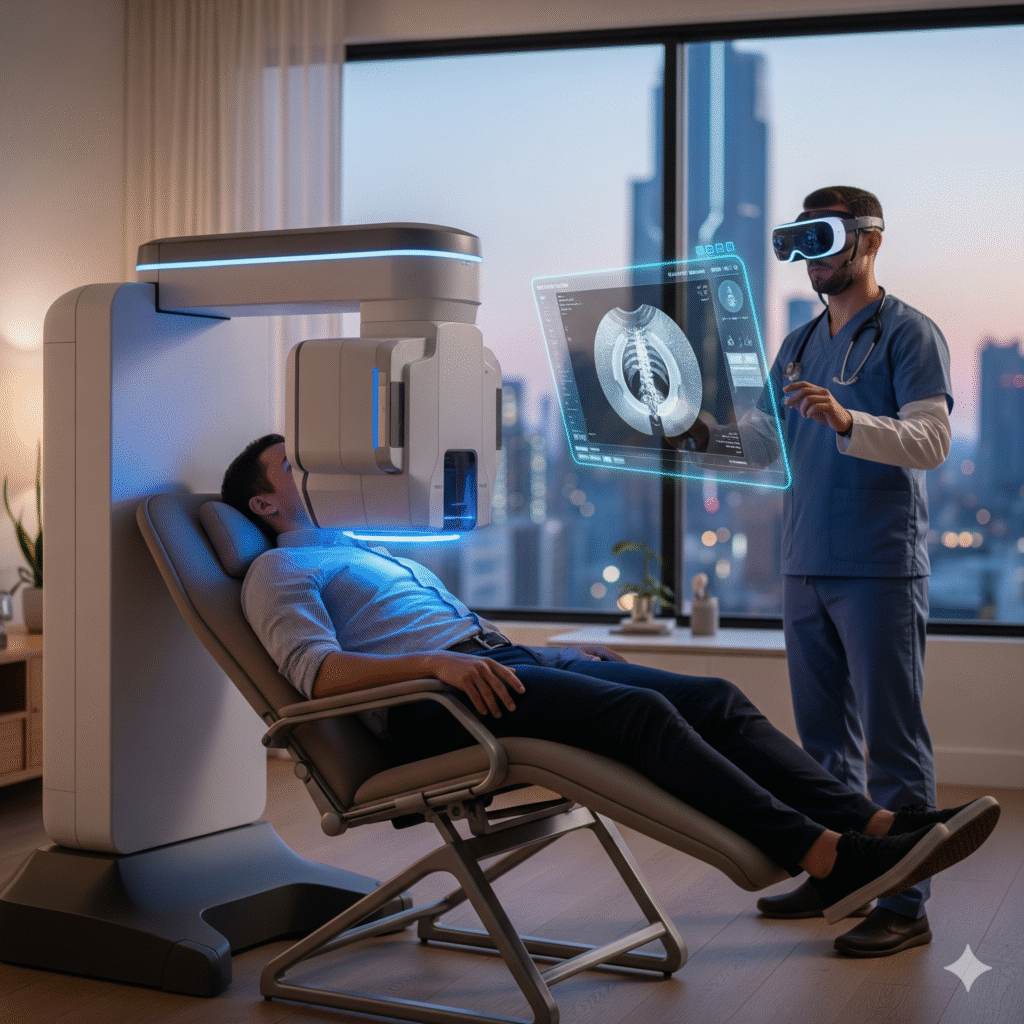
AI Integration in Radiology
Artificial Intelligence (AI) is making a big impact in the field of radiology. In the future, AI-powered tools will assist radiologists in detecting fractures, infections, and abnormalities more quickly and accurately. This will further improve the speed and reliability of X-ray at home services, ensuring patients receive the best possible care.
Growing Popularity of Home Healthcare
The demand for home healthcare is steadily rising, driven by an aging population, busy lifestyles, and the need for safe medical care at home. Along with services like nursing, physiotherapy, and teleconsultations, X-ray at home is becoming an essential part of modern home healthcare.
As awareness spreads, more patients will begin to prefer home-based radiology over traditional hospital visits.
Expanding Services Beyond X-Rays
While X-rays are currently the most common home-based imaging option, future advancements may allow ultrasounds, ECGs, and other diagnostic tests to be performed at home with equal efficiency. This expansion will make home healthcare more comprehensive, reducing the need for hospital visits even further.
Conclusion
X-ray at home with professional radiology services is a revolutionary step in modern healthcare, offering patients convenience, comfort, and reliable diagnostics without leaving their homes. Whether it’s for elderly patients, children, or individuals with chronic illnesses, this service ensures timely and safe medical imaging.
With portable digital technology, trained technicians, and expert radiologists, home-based X-rays are just as accurate as traditional hospital scans. They save time, reduce stress, and lower the risk of infections. Looking ahead, the integration of AI and telemedicine will make home radiology services even more advanced and accessible.
In a world where healthcare is moving toward patient-centered solutions, X-ray at home stands out as a game-changer—bringing hospitals to our doorstep.
FAQs
1. Is X-Ray at Home Safe?
Yes, X-ray at home is completely safe. Portable machines use low radiation, and technicians follow strict safety protocols with protective shields and proper positioning.
2. How Quickly Can I Get Reports from X-Ray at Home?
Most patients receive digital reports within a few hours of the scan. In urgent cases, radiologists can provide results even faster.
3. What Equipment is Used in Home X-Ray Services?
Portable digital X-ray machines are used. They are lightweight, compact, and capable of producing high-quality images instantly.
4. Can Children Get an X-Ray at Home?
Yes, children can safely undergo X-rays at home. The environment is more comfortable and less stressful compared to hospitals.
5. Are X-Ray at Home Services Available 24/7?
Many providers offer round-the-clock X-ray at home services, making them accessible during emergencies and night-time situations.

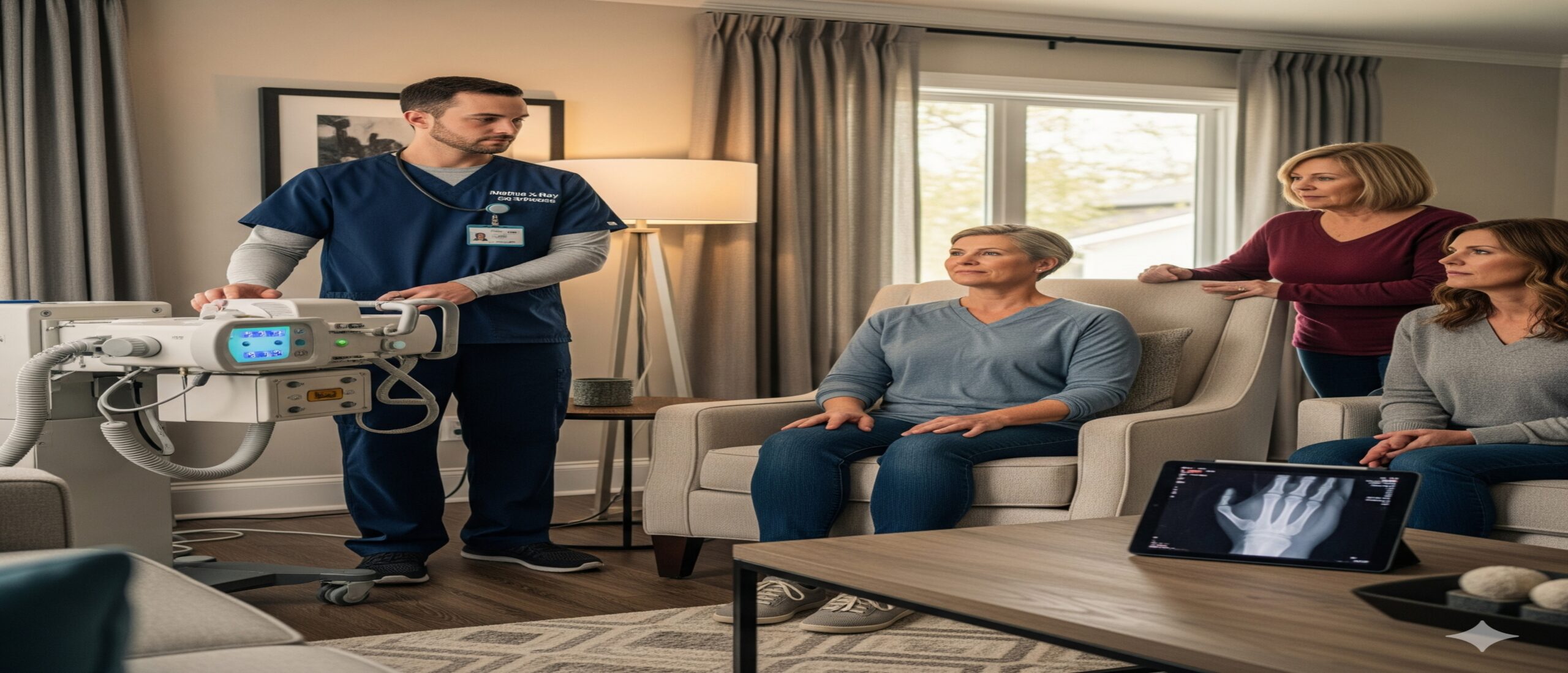
Leave a Reply